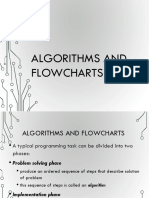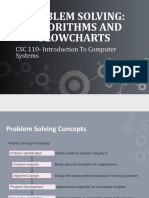0 ratings0% found this document useful (0 votes)
71 viewsAlgorithm Defination Design Implementation
Uploaded by
mdmasumiceCopyright
© © All Rights Reserved
Available Formats
Download as PDF or read online on Scribd
0 ratings0% found this document useful (0 votes)
71 viewsAlgorithm Defination Design Implementation
Uploaded by
mdmasumiceCopyright
© © All Rights Reserved
Available Formats
Download as PDF or read online on Scribd
You are on page 1/ 7
WHAT IS AN ALGORITHM?
It is a set of instructions of how to carry out a process. An algorithm lists the steps that must
be followed to complete the process and to reach the solution
Input List
Algorithm
Output List
Examples:
+ Aknitting pattem
+ Asset of instructions telling you how to put a kit together (eg. an kitchen unit)
+ Arecipe in a cook book
+ An algorithm can be represented diagrammatically in the form of a flow chart,
Algorithm constructions:
‘There are three different constructions of algorithms
do action |
do action 2
0 action
a Sequence
ira condition Is tu
[hie condition is tue,
'b Decision ‘c Repetition
Properties of Algorithms:
+ An algorithm is an exact specification of how to solve a computational problem
+ An algorithm must specify every step completely, so a computer can implement it
without any further “understanding”
+ An algorithm must work for all possible inputs of the problem.
+ Algorithms must be:
* Correct: For each input produce an appropriate output
+ Efficient: run as quickly as possible, and use as little memory as possible ~ more
about this later
+ There can be many different algorithms for each computational problem.
rithms Phases:
A typical programming task can be divided into two phases:
1. Problem solving phase (Designing)
+ produce an otdered sequence of steps that describe solution of problem
+ this sequence of steps is called an algorithm
2. Implementation phase
+ implement the program in some programming language
Problem solving phase (Designing) :
Steps in Problem Solving
+ First produce a general algorithm (one can use psetdocode)
+ Refine the algorithm successively to get step by step detailed algorithm that is,
very close to a computer language.
+ Pseudocode is an artificial and informal language that helps programmers
develop algorithms. Pseudocode is very similar to everyday English
Pseudocode Example:
Example 1; Write an algorithm to determine a student’s final grade and indicate whether it is
passing or failing. The final grade is calculated as the average of four marks.
Pseudocode:
© Input a set of 4 marks
© Calculate their average by summing and dividing by 4
«if average is below 50
Print “FAIL”
else
Print “PASS”
‘The Flowchart:
+ (Dictionary) A schematic representation of a sequence of operations, as in a
manufacturing process or computer program
+ (Technical) A graphical representation of the sequence of operations in an
information system or program. Information system flowcharts show how data flows
from source documents through the computer to final distribution to users. Program
flowcharts show the sequence of instructions in a single program or subroutine.
Different symbols are used to draw each type of flowchart.
+ shows logie of an algorithm
+ emphasizes individual steps and their interconnections
+ e.g. control flow from one action to the next
Flowchart Symbols:
Nome ‘symbol
Puabovan fi]
Rectangle
->
CO)
Hybia
Fw ting, ————»
Use in Flowenort
Denotes the beg ning or end a the program
Donotas an input operation
Denotes a process to be card out
129, addon, subiracion, dion ete,
Denotes a decision for branch) to be made
‘The program should cantiwe along one of
‘wo toutes. (e.g, FTHENELSE)
Donoios an output operation
Denotes the dection of age Yow inthe program
+ A flowchart consists of a sequence of instructions linked together by arrows to show
the order in which the instructions must be carried out.
+ Itprovides detailed steps.
+ Each instruction is put into a box. The boxes are different shapes depending upon
what the instruction is.
Example 1:
MAKING A CUP OF TEA!
Pseudocode:
1, Take tea bag out of cup
Boil the water
Put tea bag in cup
‘Add milk?
Pour boiling water in cup
Fill kettle
Stir
Ready
ee Nae ee DY
‘Add sugar ?
10, Fetch cup
Algorithm:
1. Fill kettle
Boil the water
Fetch cup
Put tea bag in cup
Pour boiling water in cup
Take tea bag out of cup
‘Add sugar ?
Stir
Add milk?
ee Nae ee
10. Stir
11. Ready
Example 2: Gar)
Grade students to identify pass & fail. LEEW
Algorithm:
Step I: Input M1,M2,M3,M4
Step2; GRADE « (M14M24M34Mayi4 x cite x
Step3: if (GRADE
You might also like
- Lecture-2.3-Flowchart Algorithm PseudocodeNo ratings yetLecture-2.3-Flowchart Algorithm Pseudocode21 pages
- Writing An Algorithm, Pseudocode, and FlowchartNo ratings yetWriting An Algorithm, Pseudocode, and Flowchart13 pages
- Cs112 - Programming Fundamental: Lecture # 04 - Pseudocode and Flow Chart Syed Shahrooz Shamim100% (1)Cs112 - Programming Fundamental: Lecture # 04 - Pseudocode and Flow Chart Syed Shahrooz Shamim60 pages
- Lecture 2 Problem Solving Techniques AlgorithimsNo ratings yetLecture 2 Problem Solving Techniques Algorithims47 pages
- 1-Introduction To Algorithms-Flowcharts-PseudocodesNo ratings yet1-Introduction To Algorithms-Flowcharts-Pseudocodes31 pages
- Algorithms, Flowcharts, Data Types and PseudocodeNo ratings yetAlgorithms, Flowcharts, Data Types and Pseudocode49 pages
- Lecture 1_B_Algorithms-and-Flowchart_TutorialNo ratings yetLecture 1_B_Algorithms-and-Flowchart_Tutorial26 pages
- Problem Solving: Algorithms and Flowcharts: CSC 110-Introduction To Computer SystemsNo ratings yetProblem Solving: Algorithms and Flowcharts: CSC 110-Introduction To Computer Systems19 pages
- Chapter 2: Algorithm Chapter 2: Algorithm: by The End of This Chapter, Students Should Be Able ToNo ratings yetChapter 2: Algorithm Chapter 2: Algorithm: by The End of This Chapter, Students Should Be Able To39 pages
- Algorithm, Pseudocode, Flowchart What Is An Algorithm?100% (1)Algorithm, Pseudocode, Flowchart What Is An Algorithm?7 pages


























































